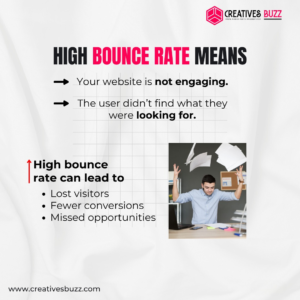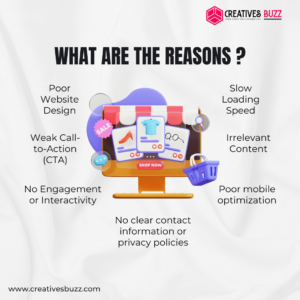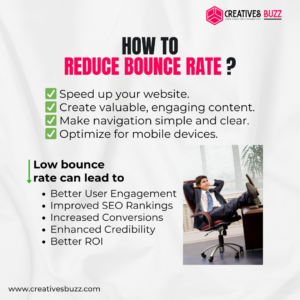Bounce rate is an essential metric for website owners and digital marketers, providing insights into the effectiveness of your website. It represents the percentage of visitors who leave a webpage without interacting, such as clicking on links, filling out forms, or making purchases. In Google Analytics, a bounce is defined as a session where users don’t engage, leaving the page within a short period.

What Defines an Engaged User?
In the context of Google Analytics, an engaged user is someone who:
- Spends more than 10 seconds on your site
- Visits at least two pages
- Completes a conversion event (e.g., signing up, purchasing)
A high bounce rate typically signals that visitors are not finding the content or actions they expect. Let’s dive into why this matters and how you can improve your website’s bounce rate.
Why Bounce Rate Matters for SEO and User Engagement
A high bounce rate can be a red flag for several reasons:
- Impact on SEO Rankings: Search engines, including Google, view a high bounce rate as an indicator of a bad user experience or low-quality content. This could harm your site’s SEO rankings.
- Lower Engagement: If visitors leave without interacting with your website, your engagement metrics (such as time on site and pages per session) will suffer.
- Reduced Conversions: When users leave without converting (e.g., completing a purchase, signing up), you miss valuable opportunities to generate leads or sales.
In contrast, websites with lower bounce rates tend to experience higher engagement, longer sessions, and improved SEO rankings.
How to Calculate Bounce Rate
Bounce Rate is calculated using the following formula:
Bounce Rate (%) = (Single-Page Sessions / Total Sessions) × 100
For example, if your site has 100 visitors in a day and 30 of them only viewed one page, your bounce rate would be 30%.
This formula gives insight into the first-level engagement with your site, helping you understand how well your content is holding visitors’ attention.
Industry Average Bounce Rate
Bounce rates vary depending on the type of website and traffic source. Here’s an overview of the average bounce rates across different industries:
- E-commerce sites: 20-45%
- Lead generation sites: 30-55%
- Blogs: 70-90%
- Landing pages: 60-90%
Additionally, traffic sources play a role in bounce rates. For example, email and referral traffic generally have lower bounce rates compared to social media and display ads.
Common Causes of High Bounce Rate
Understanding the common causes of a high bounce rate is key to improving your website’s performance:
- Mismatch Between Expectations and Content: If visitors land on a page and the content doesn’t meet their expectations, they’ll leave immediately.
- Poor Design: A cluttered or outdated design can discourage users from interacting with your site.
- Bad User Experience (UX): Difficult navigation, slow load times, and unresponsive layouts can frustrate visitors and drive them away.
- Content Irrelevance: If the content doesn’t align with the user’s intent, they won’t stick around.
- Satisfactory Single-Page Experience: Not all bounces are bad. A visitor might find everything they need on one page and leave satisfied.

How to Reduce Bounce Rate
Here are actionable strategies to lower your bounce rate and increase conversions:
- Enhance Readability: Break up large blocks of text with bullet points, headings, and subheadings. Make content easy to scan and digest.
- Improve User Experience: Ensure smooth navigation and a clean layout that guides visitors intuitively through your site.
- Create Compelling Calls-to-Action (CTAs): Use action-oriented language, highlight value propositions, and make CTAs stand out with contrasting colors.
- Deliver Relevant Content: Ensure your content is valuable, up-to-date, and tailored to the needs of your target audience.
- Optimize Loading Times: Slow-loading pages can frustrate visitors, leading to higher bounce rates. Aim for loading times of under 2-3 seconds.
- Increase Credibility with E-E-A-T: Demonstrate Expertise, Authority, and Trustworthiness in your content to enhance its credibility.
- Use Internal Linking: Guide users to other valuable content on your site with internal links, keeping them engaged longer.

Conclusion: Bounce Rate and Website Performance
Bounce rate is a crucial metric that indicates the level of user engagement and the effectiveness of your website. While some bounces are natural (like a single-page visit), a high bounce rate generally signals issues with your content, design, or user experience.
By implementing the strategies outlined in this blog—improving UX, optimizing load times, delivering relevant content, and using compelling CTAs—you can reduce your bounce rate and boost your site’s conversion rates.

Nice & Easy to understand
Very helpful